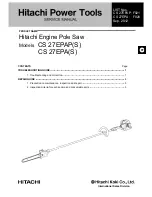
17
English
ROTATING THE MITER TABLE (FIG 21)
CAUTION
:
Always tighten the miter lock knob to
secure the miter table in position before cutting
with the miter saw.
To rotate the miter table, turn the miter lock (1) handle one or two
turns in the counter-clockwise direction, using your forefinger pull
up on the detent lever (2) located under the miter lock handle.
Using the miter lock handle rotate the miter table to the desired cut
angle. Remove your finger from the detent lever and tighten the
locking handle firmly turning it in a clockwise direction, to secure
the miter table into the desired cut angle position.
NOTE
:
This miter saw comes with 9 positive stops, 0° for 90° cutting, left-15°, 22.5° , 30°, 45°, right-15°,
22.5°, 30°, 45° for quick setting of common miter cutting angles.
POINTER AND SCALE (FIG 21)
An arrow shaped pointer (3) is located at the forward end of the miter saw insert plate. Each line on the miter scale
(4) represents 1°. When the miter table is rotated the pointer is moved from one line to the next along the miter
scale, changing the angle of cut by one degree.
SLIDING MITER FENCE (FIG 22)
The saw is equipped with left and right miter fences. Each miter
fence consists a fixed fence (1) on the bottom and a sliding fence
(2) on the top. The sliding feature allows both fences (left and right)
to be moved when making bevel or compound cuts.
To slide the sliding miter fence, loosen the fence screw (3), slide
the fence to desired position, retighten the fence screw to secure
the sliding fence. The sliding fence is pre-marked 0°, 30° and 45°
to indicate the safe fence position for bevel cuts at that angle.
TILTING THE CUTTING HEAD FOR BEVEL CUTTING (FIG 23, 24)
Depending upon the initial position of the cutting head you might
be required to place the 90° positive stop block (3) in the horizontal
position as described in the Adjustment Section of the Operator’s
Manual.
Your compound miter saw is equipped with a cutting head that can
be tilted 45° both LEFT and RIGHT.
Turn the bevel lock lever (1), located at the front of the saw, in an
upward direction to disengage the bevel adjustment allowing you
to control the cutting head freely. Move the cutting head to the
desired angle using the bevel adjustment scale (2) as a reference.
Make sure the red line on the bevel indicator is aligned with your
desired cutting angle on the bevel cutting scale.
Firmly turn the bevel lock lever in a downward direction, locking
the cutting head at the desired bevel. Confirm the cutting head is
locked securely by applying a small amount of lateral pressure
to the D-handle. If the cutting head remains at the correct bevel
location you have completed this process successfully. If the
cutting head moves realign the bevel as instructed above and
tighten the bevel lever more firmly.
Each line on the bevel scale represents one degree of movement. The angle setting is indicated by a stationary
red pointer and the bevel angle position of the cutting arm is determined by the position of the red pointer to a line
on the bevel scale.
Positive stops are provided at 90°, 45° LEFT and 45° RIGHT for quick adjustments.
FIG 21
3
1
2
4
FIG 22
2
3
1
1
FIG 23
2
3
FIG 24
















































